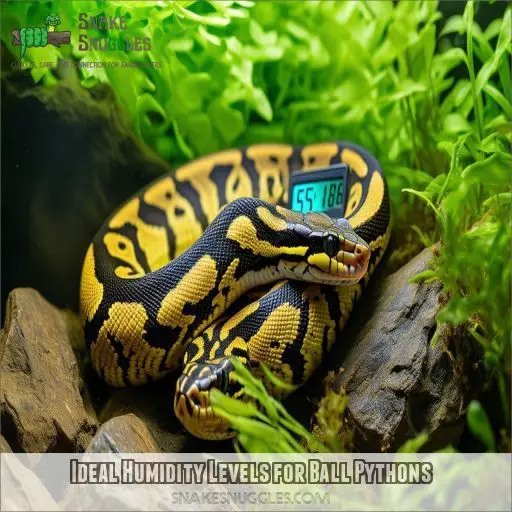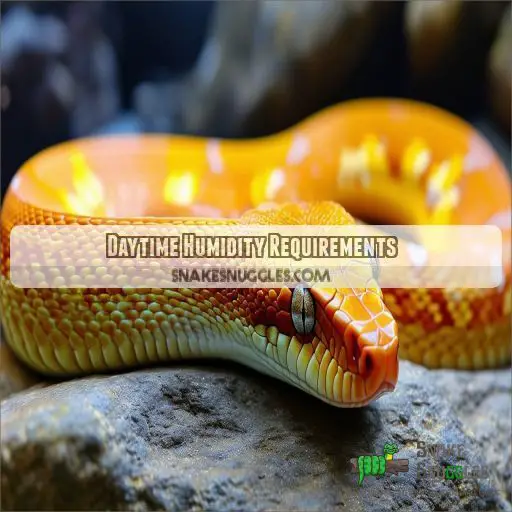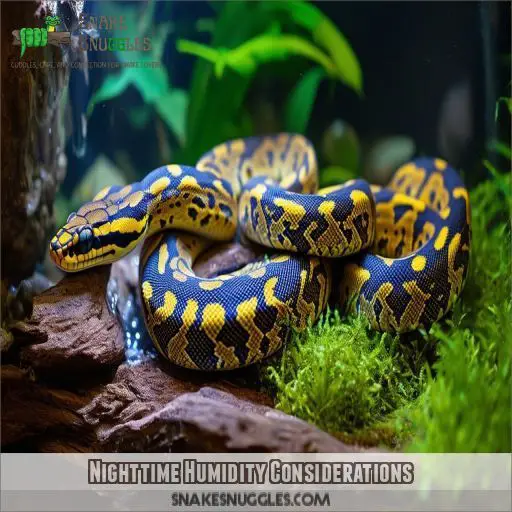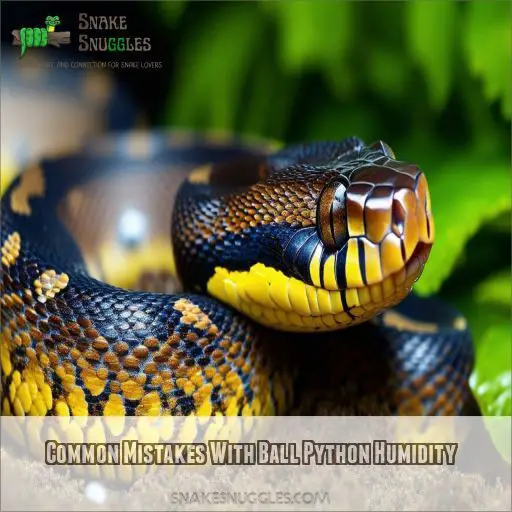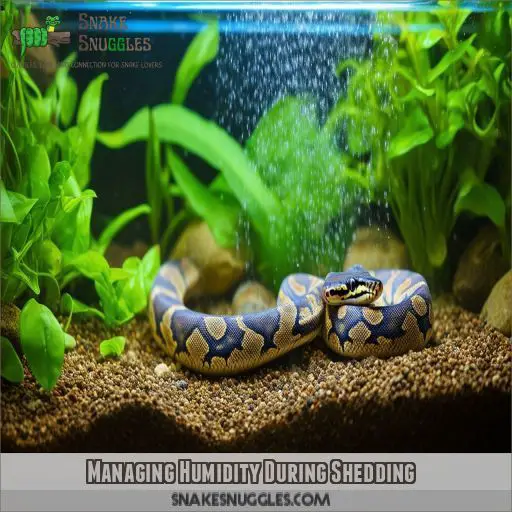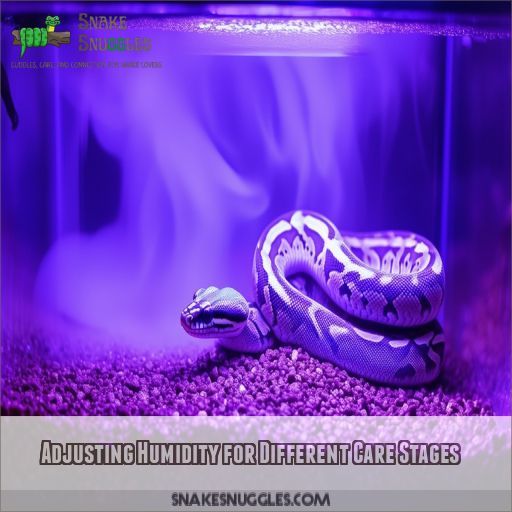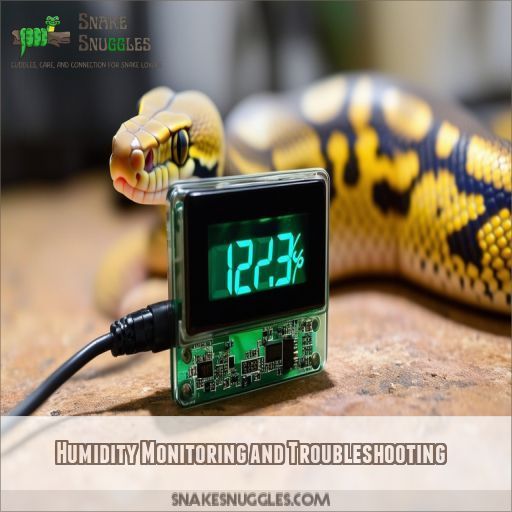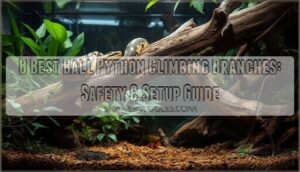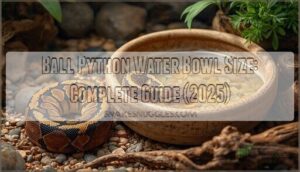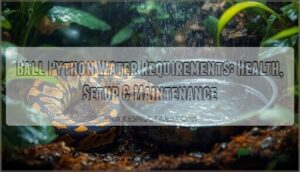This site is supported by our readers. We may earn a commission, at no cost to you, if you purchase through links.
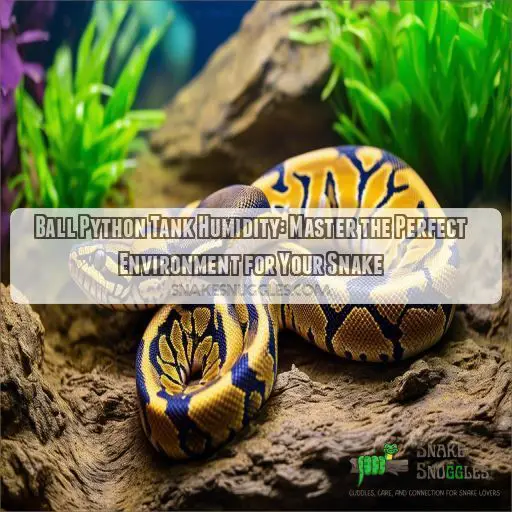
You’re going to want to narrow it down to that thin line between too dry and too damp so that your python thrives in the environment he wants to be in.
From daytime requirements to nighttime considerations, this guide will arm you with what you need to know in quest of that perfect moisture balance.
Now it’s time to dive into the world of ball python tank humidity and unlock some secrets for a contented, healthy snake.
Table Of Contents
- Key Takeaways
- Ideal Humidity Levels for Ball Pythons
- Daytime Humidity Requirements
- Nighttime Humidity Considerations
- Tips for Maintaining Optimal Humidity
- Common Mistakes With Ball Python Humidity
- Preventing Respiratory Issues
- Managing Humidity During Shedding
- Adjusting Humidity for Different Care Stages
- Humidity Monitoring and Troubleshooting
- Frequently Asked Questions (FAQs)
- Is 70% humidity too high for a ball python?
- How humid should a ball python tank be?
- Is 80 humidity good for ball python?
- Can a snake tank be too humid?
- How does humidity affect ball python feeding behavior?
- Can high humidity cause mold growth in substrate?
- Do different ball python morphs have varying humidity needs?
- How does room humidity impact tank humidity levels?
- Does tank size influence humidity maintenance difficulty?
- Conclusion
Key Takeaways
- It’s a delicate balancing act: Think Goldilocks and the Three Bears – not too wet, not too dry, but just right for your ball python’s comfort and health.
- Maintain a sweet spot: When choosing a snake, consider its humidity needs and experience level, as beginner-friendly snakes like Spotted Pythons or Corn Snakes adapt well to controlled humidity environments such as those in a snake terrarium humidity control. Aim for humidity between 60-80% to keep your snake’s skin healthy and its respiratory system happy.
- Fine-tune for nighttime: Give your nocturnal pal the extra moisture it needs by misting in the evenings and providing a humid hideout.
- Monitor and adjust: Keep an eye on the humidity levels and make tweaks as needed to create a harmonious environment that’s just perfect for your slithery friend.
Ideal Humidity Levels for Ball Pythons
You want to establish the perfect level of humidity for your ball python, which is supposed to be between 60-80%. This creates a good climate that will help in proper shedding and boosting a healthy respiratory system. Monitor this humidity using a good quality hygrometer.
This is variable due to parameters such as substrate moisture, evaporation rate, and temperature.
Offer a dark, humid hide full of damp moss where your snake may retreat when necessary.
Daytime Humidity Requirements
The ideal range of humidity that your ball python’s tank needs to be in is 60-80%. Such a value brings it very near to its natural environment while maintaining the integrity of their skin.
You’ll want to find that blend of misting frequency and substrate moisture to do so. Aim that with a humidity sensor. Evaporative cooling from a large water dish can help but don’t overdo it.
Keep in mind that consistently high humidity can cause respiratory infections. If you see that your snake is going to shed, then give the humidity a slight bump and provide a humid hideout.
Proper daytime humidity is important for the well-being of your python.
Nighttime Humidity Considerations
Not only that, but in attempts to best accommodate your ball python at night, you’ll want to utilize such nocturnal moisture-retention methods and evening misting techniques. You’ll also want to track the humidity regularly overnight to ensure an enclosure from 80-100% in humidity for one’s snake.
Nocturnal Moisture Retention Strategies
You should ensure that your ball python has proper humidity at night. To retain some moisture:
- Nocturnal Vaporization: Place water dishes next to heat sources.
- Varied microclimates with different depths that create differing substrate depths for condensation overnight
- Manage ventilation to maintain stable humidity.
- Optimize substrate evaporation by strategic heating.
These strategies will help balance out the heat, humidity, and habitat conditions. It can ensure that your snake is comfortable without over-handling or excessive misting. Remember, holding consistent moisture overnight is really important for the health of your python.
Evening Misting Techniques
You will also want to mist your ball python’s tank in the evening to keep proper humidity. You’ll be using a fine-mist spray bottle with room-temperature water, and you want light, even coverage when you mist your ball python’s enclosure.
Mist for about 10-15 seconds; focus on substrate and décor. Also, mist more frequently in a bioactive vivarium.
Use humidity readings to adjust how often you’re misting to be able to prevent scale rot.
Overnight Humidity Monitoring
After evening misting, you’ll want to keep tabs on your ball python’s nocturnal environment. Digital hygrometers are your best friends here, providing real-time humidity data.
Monitor how humidity correlates with overnight temperatures, as cooler air holds less moisture. Remember, UVB and basking lighting should be off, but humidity needs remain.
Aim for 80-100% humidity, adjusting as needed for your snake’s comfort.
Tips for Maintaining Optimal Humidity
Keeping proper humidity is a matter of working on the following for ball python care:
- Substrate selection: For this condition, use moisture-retentive materials such as orchid bark or coconut husk.
- Ventilation adjustment: A part of the enclosure top should be covered to reduce airflow, thus increasing the moisture level.
- Misting frequency: In terms of misting frequency, set up a regular misting schedule and adjust as necessary.
Control the humidity with the proper substrate for your animal, along with ventilation adjustments. Mist regularly, but not excessively. Observe your snake’s behavior and shedding to know if you’re hitting that sweet spot. Keeping proper humidity is essential to the health and comfort of a ball python, so you have to be vigilant about it and adjust accordingly.
Common Mistakes With Ball Python Humidity
You could be making some of those common mistakes in humidity without even realizing it. Ball pythons become stressed by fluctuations in humidity, so it’s important that the levels for captive care be consistent.
Let’s not forget to select the right substrate—one wrong choice can create moisture problems. It’s quite underestimated how much ventilation impacts humidity changes, more than one would think.
And last but not least, hygrometer placement: most of the time, it’s those wrong readings which throw off your whole setup. Some owners overdo or underdo evaporation techniques.
Take note that this is a fine line. By avoiding these common mistakes, you’ll create a healthy environment for your scaly friend.
Preventing Respiratory Issues
Staying away from common humidity mistakes is extremely important. Prevention of respiratory problems isn’t any less important for your ball python.
It’s necessary to ensure that the substrate choice has a good amount of moisture but doesn’t get waterlogged. Ensure good ventilation methods.
You have evaporative methods like misting to ensure adequate humidity. However, don’t overdo it; remember that temperature impacts humidity, so you need to consider both elements closely.
You want an environment that’s well balanced, wholly humid—like 60-80% during the day and 80-100% at night. This will keep your ball python’s respiratory system healthy.
Managing Humidity During Shedding
Your ball python needs additional moisture during the period he’s undergoing shedding for it to be as smooth as possible. Drive up humidity to 70-80% for a great shed. Here’s how you can manage the humidity during this most critical time:
- Increase misting frequency with a bias towards evenings to simulate nocturnal humidity.
- Offer a humid hide with damp sphagnum moss as a source of additional moisture.
- Utilize a moisture-retentive substrate like coconut husk to assist in maintaining higher levels of relative humidity.
Pay close attention to your snake during the shedding cycle. Monitor the symptoms regarding its respiratory system. By fine-tuning your humidity, you’ll ensure that your ball python sheds like a pro and is healthily perfect.
Adjusting Humidity for Different Care Stages
As your ball python matures, you’ll need to make further adjustments in humidity levels accordingly. Hatchlings require higher humidity, usually in the range of 60-70%—that is good for their healthy growth. In adults, you should be able to keep it between 50-60%, adjusting as you deem necessary.
During brumation, lower it even further to around 40-50%, as this tends to happen in nature at this point. Substrate selection and keeping proper humidity go hand in hand: coconut husk or cypress mulch suit both kinds of life phases.
Remember that requirements change with age. Monitor your snake for behavior and shedding patterns. This way, you’ll adjust to the changing needs of your python and ensure long-term health and comfort.
Humidity Monitoring and Troubleshooting
Since you have learned how to change the humidity at the different stages of care, you’ll need to keep constant monitoring of your ball python’s environment. Make sure that you get quality humidity sensors and set them accordingly in the enclosure. Not to mention placing thermometers—you want to remember that temperature and humidity go together.
This regular monitoring will help secure the determination of any impending issues before they become problems. If you begin to notice spikes or drops in your humidity, investigate immediately. Is your misting routine off? Has the substrate dried out?
Be vigilant, troubleshoot quickly, so you can help keep this scaly friend comfortable and healthy.
Frequently Asked Questions (FAQs)
Is 70% humidity too high for a ball python?
No, 70% humidity isn’t too high for your ball python. It’s actually ideal. You’re hitting the sweet spot, providing a comfortable environment that mimics their natural habitat. Keep it up, and your snake will thrive!
How humid should a ball python tank be?
You’ll want to keep the ball python’s tank humidity between 60%-80%. Proper shedding and overall health depend on it. Keep it low daily, but when they’re going to shed—a little crank up. Be careful not to have too much, otherwise respiratory issues can occur.
Is 80 humidity good for ball python?
While 80% humidity is acceptable for ball pythons, it’s on the higher end. You’ll want to aim for 60-70% during the day, increasing to 70-80% at night. Monitor closely to prevent respiratory issues or scale rot.
Can a snake tank be too humid?
Like a suffocating blanket, excessive humidity can be harmful. You’ll want to keep your snake’s enclosure balanced. Too much moisture can lead to respiratory issues and promote bacterial growth. Monitor levels closely and adjust as needed.
How does humidity affect ball python feeding behavior?
Proper humidity levels increase your ball python’s appetite and improve digestion. More frequent feeding, smoother swallowing—and the best overall health—are what you’ll see. Keep it at 60-80% to feel comfortable and ready to eat.
Can high humidity cause mold growth in substrate?
Imagine a lush, tropical forest floor teeming with life. You’ll soon discover that high humidity indeed fosters the growth of mold in substrate. Proper ventilation and controlled moisture are the keys to preventing any unwanted fungus guests from joining your snake’s habitat.
Do different ball python morphs have varying humidity needs?
No, ball python morphs all have the same requirements in terms of humidity. All the morphs require a constant 60-70% RH with slight increases to 80%, especially during shedding periods, in order to be healthy and shed successfully.
How does room humidity impact tank humidity levels?
While you mightn’t think so, room humidity really does impact the overall on-tank one. Lower room humidities may require more misting or a larger water bowl to provide optimal humidities, ensuring your reptile’s comfort and health.
Does tank size influence humidity maintenance difficulty?
Yes, tank size affects humidity maintenance. Larger tanks have more air volume, making it harder to maintain high humidity levels compared to smaller tanks. You’ll need additional measures like misting and substrate adjustment to compensate.
Conclusion
Mastering ball python tank humidity is much like running an orchestra—all the elements should be precisely calibrated.
If you follow the insights shared in this guide, you’ll be able to create an environment that features a balance of moisture perfectly suited to your slithering companion.
The heightened attention you apply daily to night toward controlling and regulating ball python tank humidity will only prove to make your snake thrive well, free of respiratory troubles and shedding issues.
Armed with this knowledge, you’ll play a symphony of health and happiness for your special ball python.

